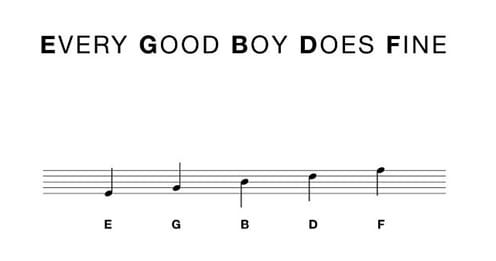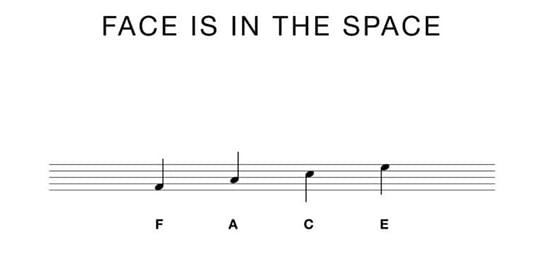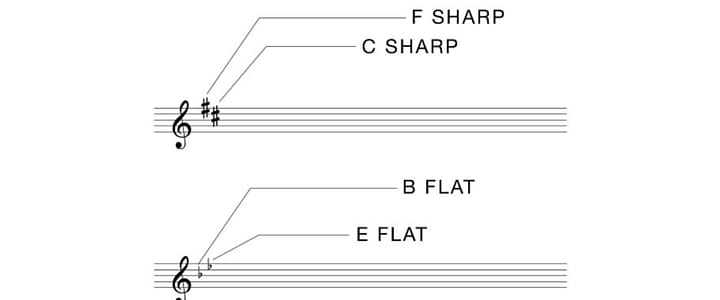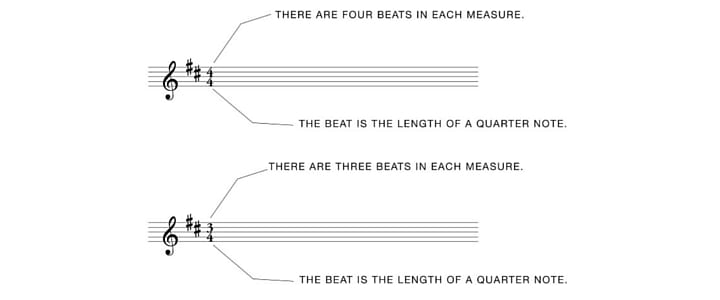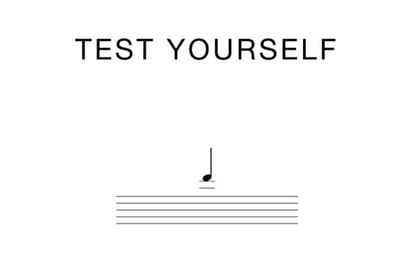Playing by ear is a wonderful and valuable skill that can come in handy in many situations, especially when it comes to improvising. However, reading violin sheet music is necessary if you aspire to perform with an orchestra, quartet, or band.
Once you know how to read violin sheet music, reading music is as easy as reading the words and letters on this page. Your brain will eventually learn how to interpret the notes and send those messages to your hands, so you can play the music accordingly. Not only will you learn the violin note names and their corresponding positions on your instrument, but you will also discover even more cues like staccato, allegro, and more.
As long as you dedicate time to studying and practicing music, you’ll be able to learn virtually any song on the violin. And the best part of all is that you can learn how to read music while building up other fundamental violin techniques such as scales, finger positions, and bowing.
Are you ready to learn how to read violin music? Then you’ve come to the right place! Below we provide a step-by-step guide to learning basic violin notes.
How to Read Violin Sheet Music: Step by Step
Believe it or not, when it comes to learning how to read notes violin, you don’t necessarily need your instrument at your side. You see, there’s a lot you can learn and gather from sheet music without even picking up your violin, such as what notes to play and what key signature to use.
The first step in violin music learning for beginners is understanding how to interpret the staff.
The Staff
The journey of learning how to read sheet music starts with the staff. The staff is the set of five horizontal lines on which notes are placed in standard violin sheet music.
There are seven notes of which all music is based: A, B, C, D, E, F and G. Once you get to G, you would start back over with A and the cycle would repeat again, getting higher in pitch as you go up the staff.
There are also multiple pitches that correspond with the same letter in music. For instance, there are several different A’s on the violin. They are just in varying forms of higher or lower pitches.
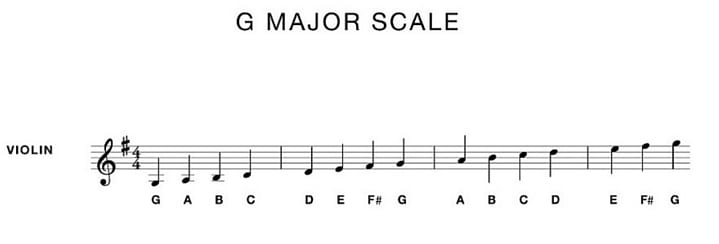 The Notes on the Lines
The Notes on the Lines
The easiest way to learn violin music notes is to divide the staff up into lines and spaces.
These are the notes that fall on the lines of the staff, meaning the notes directly on top of the lines, with the lines intersecting them.
Starting from the bottom line, begin to memorize each note going up the top line. One popular mnemonic device you may have heard is “Every Good Boy Does Fine.” Another is “Elvis’ Guitar Broke Down Friday,” or even “Every Good Boy Deserves Fudge.” It doesn’t matter which one you use as long as it helps you remember the violin notes on the staff.
You can also start with a beginner violin book, such as Essential Elements for Strings Volume I, which will give you some great exercises to help you memorize and learn these notes.
The Notes on the Spaces
Next, there are the violin music notes that fall in between the lines – on the spaces:
Another great mnemonic device applies here. If you look at the notes starting from the bottom note up to the top note, you will see that the letters spell F-A-C-E. And that of course rhymes with space. It’s quite catchy and memorable: “Face is in the space!”
Whenever you’re practicing or working from an exercise book make sure to keep these mnemonic devices in mind. If you forget the name of a note, first determine whether the note falls on a space or a line.
Then take your finger and point to each note from the bottom on up, while saying aloud the corresponding mnemonic device to refresh your memory. If you’re just starting out, you can use a pencil to write in the name of the note as a reminder, but as soon as it’s ingrained in your memory, be sure to erase it so you don’t rely on that tactic every time.
See, learning how to read violin notes isn’t that hard after all!
RELATED: Beginner’s Guide to Tuning a Violin
Ledger Lines
The five lines and four spaces aren’t quite enough to contain the entire spectrum of violin notes. In order to place these violin music notes, we use small lines or dashes called “ledger lines.” The notes can fall on the lines or in the spaces between them just like the five lines of the staff.
In the G scale chart above, you’ll notice that there are other notes that fall below the staff (lower in pitch) and above the staff (higher in pitch.)
To read these notes you can use the ones on the staff that you already know as a reference point to figure them out.
Important Symbols on the Staff
A very important part of learning how to read violin notes is memorizing the different symbols you might come across on the staff. If you look over some violin sheet music or an exercise book, you’ll notice some new symbols at the beginning of each staff line.
These symbols give you clues about how a violin song should sound, whether that’s how many beats are in a measure or if you need to play any flat versions of the notes. Before you pick up your instrument to play, study these symbols on the staff so you know what to expect. 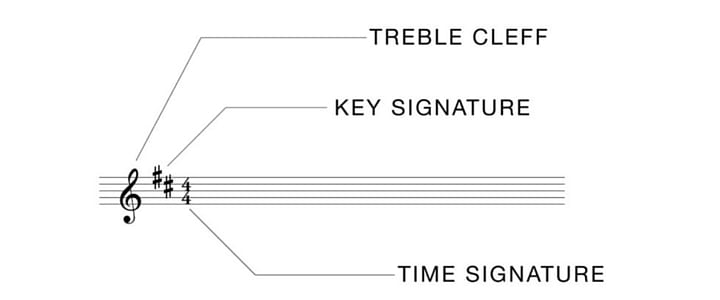
The Treble Clef
You may recognize the fancy swirly symbol at the beginning of the staff as a clef. Clef symbols are reference points that name a specific note on the staff from which the names of all the other notes are based.
Lower pitched instruments use other clefs with different reference points, such as bass or alto clef. But in violin (as well as higher pitched instruments such as flute and trumpet) we use the treble clef.
The main thing a beginner should take from this is that if you’re looking at sheet music with a treble clef on it, it signifies that the music is suitable to be played on the violin.
Key Signature
Next, you’ll see the key signature, which is very important to pay attention to because it will tell you whether or not you have any flat or sharp notes in the song.
If you see a flat symbol in the key signature, look at the line or space that is striking through the center of the symbol and determine which note corresponds to the line or space.
Now throughout the duration of the piece (whether it’s a higher or lower version of that note) you will be playing the flat version of that note.
The same goes for when you see a sharp symbol in the key signature. Take a close look at the sharp symbol and notice that there is a little skewed square right in the middle of the symbol.
Whichever note corresponds to the line or space that the square forms around will be the note that will become sharp throughout the piece.
Sometimes there will be multiple sharps or a combination of sharps and flats. If you don’t see any sharps or flats in your key signature, you can just assume that all the notes in the piece are going to be your normal or “natural” notes.
Any notes that are not mentioned in the key signature are assumed to be natural notes as well.
Time Signature
Next in line is the time signature. The time signature lets you know how to count a piece or how many beats are in each measure.
The staff is divided by vertical lines into segments called “measures,” which will contain a certain number of beats depending on what your time signature says.
In the image below, you’ll notice the time signature is 4/4. The top number in the time signature; in this case, the number four tells you how many beats are in each measure, so there are four total. Once the allotted number of beats have been counted out, it’s time to move on to the next measure and start the counting over again.
The bottom number describes the length of the beat. Again, in this example, it shows the number four. If you have a 4 on the bottom (most common), that would signify that you are basing your beat off of the length of a quarter note.
These are the numbers you’ll be seeing on the bottom of the time signature and which note lengths they correspond to:
- 2 = half note
- 4 = quarter note
- 8 = eighth note
- 16 = sixteenth note
These are the most common time signatures you will see:
The 4/4 time signature is so common that it is referred to as “common time” and often, you will see a C on the music where the time signature would normally be which means to play the piece in 4/4 time. But that’s not to say you shouldn’t experiment with other time signatures. For example, while playing in 3/4 time may seem a little tricky at first, it’s a great way to challenge yourself and expand your skills.
No matter what time signature you’re playing, one of the best ways to improve your music skills is by silently counting the beats in your head. For 4/4 time, practice counting “one-and-two-and-three-and-four,” to help you capture all the eighth notes. You can also tap your foot or use a metronome for additional help.
SEE ALSO: The Pros and Cons of the Suzuki Method
Quiz Yourself on How to Read Violin Notes
Now that you understand all the symbols and signatures at the beginning of a violin song, you’re ready to start reading notes.
Remembering your mnemonic devices can help you read the notes on the staff, but will you be able to identify the notes that fall off the staff?
As discussed earlier, there are many notes that will fall above the staff and a couple that fall below it.
Just remember that if you know the notes on the staff, you can count up or down using the alphabet to figure out any note you come across.
Test yourself with the chart below.
Starting with the top line, which you know is an F, count up alphabetically to figure out what note this is. Make sure you count each space and line!
If you guessed D, you’re right!
Remember, learning how to read violin music for beginners takes time. You probably won’t pick it up overnight, and that’s ok! Go slowly and be sure to put in plenty of practice. Once you begin to understand the basics of how to read violin notes, you’re ready to start putting it all together. You begin to learn about how these notes on written sheet music correspond to the notes on your violin, which is discussed thoroughly in this article.
While our guide is a great place to start when studying violin note names and their positions on the staff, it’s no substitute for studying with a professional music teacher. When you sign up for violin lessons, you can receive one-on-one instruction from a certified tutor who can help you achieve all your music goals. Whether you want to play certain violin songs for beginners or challenge yourself with more complex techniques, your teacher will help you every step of the way. Sign up for lessons with us today!
 Post Author: Naomi Cherie S.
Post Author: Naomi Cherie S.Naomi teaches violin in Austin, TX. She is a classically trained violinist with over 20 years of experience and a diverse musical background. Learn more about Naomi Cherie S. here.
Brooke Neuman

